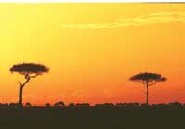The world's climate varies naturally through time. Historical records show that the Thames froze over most years in the 16th and 17th centuries, while geological records suggest that there have been times when the Earth was ice-free. One factor controlling this natural variation in climate is the amount of greenhouse gases, like carbon dioxide and methane, in the atmosphere. But the climate is a highly complicated system, which means that computer models used to simulate it will always be a simplification of the 'real' world. The most sophisticated climate models available are built on our understanding of the physics controlling the circulation of the atmosphere and ocean, and how plants respond to these conditions.
These models are used to simulate future climate scenarios but they can also shed light on the past if information about prevailing climatic conditions is available. If the model simulates known conditions accurately, we can feel more confident that the model is producing robust predictions. Thonicke's recent work has focused on understanding the vegetation conditions that existed about 21,000 years ago when the ice covering the globe was at its maximum - the Last Glacial Maximum (LGM).
The climate is a highly complicated system, which means that computer models used to simulate it will always be a simplification of the 'real' world.
Using information from ice cores and from charcoal found in sediments or peat that resulted from the burning of biomass, reconstructions have shown that during the LGM temperatures were cooler, conditions were quite dry, and atmospheric carbon dioxide concentrations were lower than today. With a large ice sheet in the Northern Hemisphere, sea levels dropped and more land was exposed to become colonised by plants. This led to the development of different atmospheric circulation and climate patterns which forced a southward shift in vegetation zones, such as the boreal forest. However, lower carbon dioxide levels resulted in less woody vegetation because it was harder for plants to photosynthesise. Consequently grasses expanded, increasing the frequency of fires. Overall, global emissions from burning biomass were slightly reduced because the increase in emissions in the tropics was more than compensated for by a decrease in the Northern Hemisphere, but the full implications of Thonicke's findings are still unknown and need further investigation. Once she has all the data they will be fed into climate simulation models to help refine predictions for future climate change.
BRIDGE - The Bristol Research Initiative for the Dynamic Global Environment - will use the improved understanding of these complex interactions provided by Thonicke and other members of the team to help predict future changes more accurately, and to assess their impact on all aspects of human society. BRIDGE will then make this information available to the Intergovernmental Panel on Climate Change, which ultimately feeds into governments' policy considerations.
